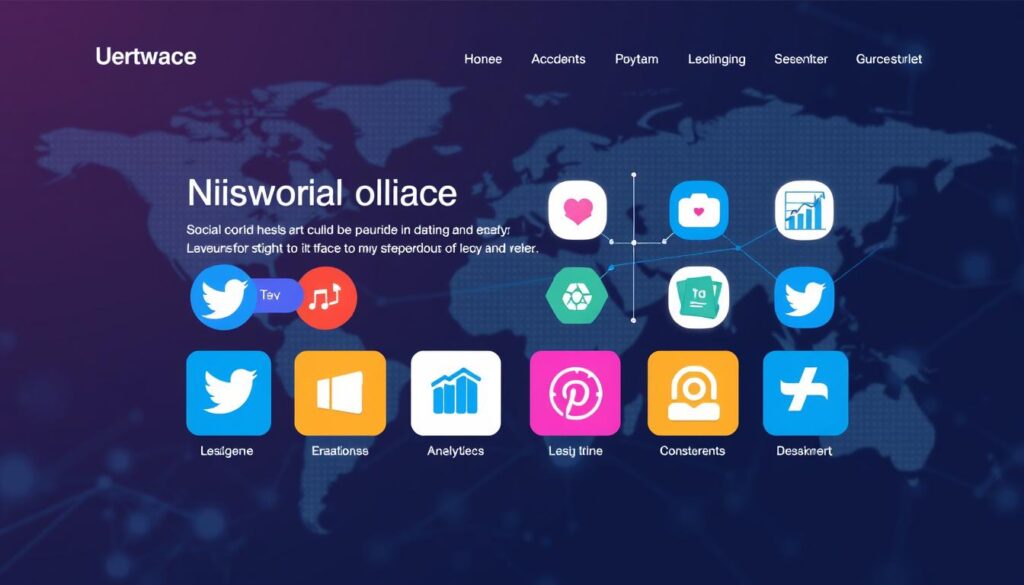Did you know that 70% of marketers affirm social media’s efficacy in augmenting SEO? This revelation highlights the critical role of social media integration within contemporary SEO strategies. Brands such as HubSpot and Buffer exemplify how social media optimization can elevate online presence and stimulate organic search traffic. To succeed in the fiercely competitive digital arena, enterprises must exploit the symbiotic relationship between social media platforms and SEO endeavors, ensuring they remain pertinent and foster meaningful interactions with their audience.
By embracing social media integration, corporations can tap into the collective potential of these platforms, thereby enhancing search engine rankings and user engagement. This synergy is pivotal, whether through maintaining consistent branding or disseminating impactful content. The scope for expansion and visibility is vast. For a deeper exploration of this subject, refer to this comprehensive guide.
Key Takeaways
- Social media integration can significantly impact your SEO results.
- Platforms like HubSpot effectively utilize social media for increased visibility.
- Engaging content shared on social media enhances user interaction.
- A cohesive branding strategy across all platforms boosts recognition.
- Understanding social media algorithms is crucial for optimizing posts.
- Establish clear goals to guide your social media and SEO integration efforts.
- Regularly measure performance to refine your strategies.
Understanding Social Media Integration and SEO
In the current digital epoch, grasping the essence of social media integration is crucial for augmenting your digital footprint. This endeavor entails leveraging the capabilities of social media platforms to amplify visibility and steer traffic towards websites. Enterprises must recognize the significance of social media in achieving superior SEO results, as it cannot be overlooked.
What is Social Media Integration?
Social media integration embodies the fusion of social networks into your digital strategies. This methodology enables brands to forge a unified link between their social profiles and websites. It encompasses the dissemination of content, interaction with followers, and the utilization of user-generated content. By employing social media as a conduit, not only is content promotion facilitated, but direct website traffic is also stimulated, thereby cultivating a vibrant digital presence.
The Connection Between Social Media and SEO
The symbiotic relationship between SEO and social media is becoming more apparent as search engines progress. Social signals, such as likes, shares, and comments, directly influence search engine rankings. Studies reveal that content shared on social platforms generates backlinks and increases referral traffic to websites. This surge in activity signals to search engines the value of the content, thereby enhancing SEO rankings.
Benefits of Social Media Integration for SEO
Social media’s pivotal role in augmenting online presence cannot be overstated. Brands across various sectors have recognized the value of social media integration in SEO, leading to a marked enhancement in their marketing endeavors. This synergy facilitates broader audience reach and fortifies brand loyalty.
Increased Visibility and Reach
The integration of social media with SEO significantly enhances increased visibility. Content dissemination through social media platforms widens its exposure to a larger demographic. This expansion in reach can catalyze an uptick in organic search traffic. Content that captivates audiences tends to garner more shares and backlinks, thereby amplifying its overall efficacy.
Enhanced User Engagement
Social media excels in fostering engagement. Posts on platforms such as Facebook or Twitter can provoke user interactions, including comments, queries, and discussions. This dynamic fosters a reciprocal dialogue, underscoring the importance of social media integration in SEO.
Brand Awareness Boost
Established brands like Nike and Starbucks exemplify the efficacy of social media in elevating brand awareness. Strategic campaigns enable the dissemination of messages across vast audiences, cultivating a devoted community. For entities aiming to bolster brand visibility and engagement, the strategic utilization of social media is imperative. For further guidance on integrating these platforms, feel free to contact us.
Key Strategies for Effective Social Media Integration
To integrate social media effectively for SEO, a strategic approach is imperative. Focus on strategies that amplify brand recognition and augment online presence. Consistency in branding and astute hashtag utilization are crucial for a successful social media strategy.
Consistent Branding Across Platforms
Uniformity in brand image across various social media platforms is essential for establishing a robust identity. Such consistency enables users to swiftly identify your brand, cultivating trust and loyalty. The maintenance of consistent logos, colors, and messaging fortifies the bond with your audience. Brands that excel in consistent branding typically experience enhanced engagement, thereby magnifying the efficacy of their SEO initiatives.
Utilizing Hashtags Effectively
Hashtags are instrumental in elevating the visibility of your content. Studies reveal that tweets with hashtags can garner 33% more engagement than those without. In crafting your social media strategy, incorporate pertinent hashtags that align with your audience’s interests and industry trends. A judiciously chosen hashtag can significantly enhance discoverability and facilitate connections with new followers. For a deeper dive into the role of hashtags, refer to this resource.
Best Social Media Platforms for SEO

The selection of appropriate platforms for social media marketing is paramount in enhancing online presence. Each platform boasts distinct strengths, catering to diverse audiences and marketing strategies. Grasping these attributes is essential for effective integration with SEO efforts.
Facebook: A Giant in Marketing
Facebook stands as a behemoth in the realm of social media marketing, boasting an extensive user base. Its billions of active users offer unparalleled reach for marketers. Through targeted ads, brands can engage specific demographics, thereby boosting visibility across search engines. The sharing of valuable content via posts enhances engagement, ensuring sustained audience connection.
Twitter: Real-Time Engagement
Twitter’s prowess in facilitating real-time engagement makes it a prime choice for social media marketing. Its fast-paced environment enables brands to engage in trending conversations, cultivating a community around their offerings. By disseminating concise, impactful messages, businesses can drive site traffic while enhancing SEO through engagement metrics.
Instagram: Visual Storytelling
Instagram’s core focus on visual storytelling captivates users, particularly millennials and Gen Z. It emerges as a standout platform for SEO, leveraging high-quality images and videos. The creation of visually appealing posts increases user engagement, while strategic hashtag use enhances discoverability. Brands must prioritize authentic content that resonates with their audience, seamlessly integrating social media marketing into their broader strategy.
Delving into these platforms is crucial for effective social media marketing and SEO improvement. Each platform presents unique opportunities for elevating online visibility and driving traffic. For further insights on maintaining compliance while leveraging social media, refer to this informative link.
How to Optimize Social Media Profiles
In the realm of digital marketing, the creation of engaging social media profiles is paramount. Brands can significantly bolster their online footprint through the meticulous optimization of their social media profiles. A profile that is structured with precision can effectively convey the brand’s ethos. The bio descriptions, in particular, hold immense potential for enhancing user engagement and visibility.
Crafting Compelling Bio Descriptions
The bio on social media platforms serves as a gateway to your brand’s essence. It must encapsulate your identity and values succinctly. The strategic incorporation of *keyword usage in bios* is pivotal for search engine optimization. This tactic attracts users seeking specific content, thereby increasing your visibility. The objective is to craft a bio that:
- Articulates your brand’s core values.
- Engages followers through thought-provoking questions or calls to action.
- Employ humor or creativity to reflect your brand’s personality.
Utilizing Keywords Wisely
Strategic keyword implementation is crucial for enhancing discoverability. The judicious use of *keyword usage in bios* significantly boosts the likelihood of appearing in search results. It is imperative to integrate keywords that resonate with your brand and target audience. Consider these strategies to refine your profile:
- Conduct thorough research to identify industry-specific keywords.
- Ensure keywords are seamlessly integrated into your content.
- Regularly update keywords to reflect evolving trends or services.
Creating Shareable Content for Social Media
The art of crafting shareable content is paramount for maximizing engagement on social media platforms. Grasping the essence of what captivates audiences and facilitates effortless sharing is crucial for enhancing your social media SEO strategies. The emphasis on visuals and impactful headlines is instrumental in motivating users to disseminate your content.
Tips for High-Quality Visuals
Visual appeal is the first point of contact, capturing attention instantaneously. To achieve high-quality visuals:
- Employ captivating graphics that resonate with your brand’s identity.
- Integrate videos that narrate compelling stories or impart valuable insights.
- Optimize images for diverse devices to ensure universal accessibility.
- Explore different formats to identify the most resonant with your audience.
Engaging Headlines and Captions
Headlines and captions act as the portal to your content. Crafting engaging lines involves:
- Employing attention-grabbing phrases that stimulate curiosity.
- Maintaining brevity while ensuring clarity, allowing for quick comprehension.
- Integrating questions to foster interaction and sharing.
- Emphasizing unique aspects that set your content apart.
Brands such as BuzzFeed illustrate the efficacy of compelling visuals and headlines, leading to viral content strategies. By adopting these social media SEO techniques, your content can transcend its original audience, reaching a broader demographic.
Tracking and Measuring Success
Grasping the conversion of social media endeavors into concrete outcomes is paramount for any marketing blueprint. The act of monitoring social media performance metrics is essential for assessing the efficacy of campaigns and pinpointing avenues for enhancement. Through precise analysis of success, marketers can refine their tactics to foster deeper audience engagement and elevate overall performance metrics.
Key Metrics to Monitor
To evaluate the efficacy of social media integration, concentrate on the following pivotal metrics:
- Engagement Rates: Examine likes, shares, comments, and other interactions to assess audience connection.
- Reach: Track how many individuals view your posts, which helps gauge visibility.
- Referral Traffic: Analyze how much traffic your website receives from social media platforms.
- Conversion Rates: Measure actions taken by visitors from your social media channels, such as sign-ups or purchases.
Tools for Analyzing Performance
Employing the appropriate tools significantly enhances your capacity to monitor social media performance metrics effectively. Consider these options for analyzing success:
- Google Analytics: This robust tool offers valuable insights into website traffic and user behavior, enabling sophisticated analysis of social media contributions.
- Sprout Social: A dedicated platform for social media analytics that provides engagement data, audience growth, and performance reports.
Integrating Social Media into Your Website

Initiating the process of integrating social media into your website can profoundly elevate user engagement and amplify visibility. This endeavor encompasses two pivotal components: embedding social sharing buttons and showcasing feeds from diverse social media platforms.
Embedding Social Sharing Buttons
The inclusion of social sharing buttons on your website empowers visitors to disseminate content across their preferred social networks with unparalleled ease. These buttons streamline the sharing process, thereby incentivizing readers to amplify your brand’s reach. Consequently, this strategy augments your brand’s visibility and attracts a broader audience. Strategically position these buttons in highly visible areas, such as the top or bottom of blog posts, to maximize their impact.
Displaying Feeds from Social Media
Displaying social media feeds directly on your website is another efficacious tactic. This method not only maintains your site’s vibrancy and appeal but also cultivates a sense of community among visitors. The display of real-time updates and interactions from your social platforms can motivate users to follow your profiles and engage more deeply. Brands like Buffer exemplify this strategy, leading to more immersive user experiences and heightened engagement levels.
Overcoming Common Challenges in Social Media Integration
Organizations frequently encounter hurdles in social media integration, notably in managing adverse feedback and ensuring content’s timeliness. Mastery over these obstacles can markedly enhance an entity’s digital footprint and engagement with its audience.
Dealing with Negative Feedback
Effective management of negative feedback is paramount in preserving a favorable online image. Swift and courteous responses to criticism can transform a detrimental scenario into an opportunity for advancement. Essential considerations include:
- Engage attentively with customer grievances.
- Validate their sentiments and express regret where applicable.
- Offer a viable solution or support to rectify the problem.
- Verify customer satisfaction with the resolution.
Maintaining Up-to-Date Content
Consistent content refreshment is essential for sustaining audience interest. Current content attracts visitors and motivates them to revisit. Consider the following strategies for ensuring content remains current:
- Regularly review existing content to identify outdated elements.
- Stay abreast of industry developments and news to offer pertinent insights.
- Utilize a content calendar to orchestrate timely posts across various platforms.
The Future of SEO and Social Media Integration
The evolution of SEO and social media landscapes necessitates a proactive stance from brands to navigate emerging trends. The proliferation of video content and the advent of social commerce redefine the paradigm of future social media integration. Acquaintance with and adaptation to these phenomena are paramount for sustaining visibility and fostering engagement within this rapidly shifting milieu.
Emerging Trends to Watch
Several trends will shape the future of SEO and social media integration, including:
- Increased Video Content: The ascendancy of short-form videos, live streaming, and interactive formats in garnering engagement prompts brands to craft engaging video content.
- Social Commerce Growth: The enhancement of shopping functionalities on platforms like Instagram and Facebook necessitates the utilization of these tools to augment sales through social channels.
- AI and Personalization: The deployment of artificial intelligence will enhance targeting and personalization, thereby creating bespoke experiences for users.
Adapting to Algorithm Changes
The imperative for brands to remain agile in the face of algorithmic modifications on platforms such as Google, Facebook, and Instagram cannot be overstated. A proactive approach towards understanding the repercussions of these changes on visibility is crucial. Essential strategies encompass:
- Consistent updates to content to align with evolving algorithmic preferences and user behaviors.
- Engagement with audiences through comments and direct messages to augment interaction.
- Analysis of performance metrics to discern successful content types and strategies.
Practical Steps to Start Integrating Today
The initiation of social media integration necessitates meticulous planning and a strategic mindset. The foundational step involves the establishment of clear, quantifiable objectives. These objectives serve as a compass, guiding your endeavors and task prioritization, thereby ensuring your social media strategy is in sync with your broader marketing objectives. Determine your desired outcomes—whether it’s elevating brand visibility, augmenting engagement, or increasing website traffic—and formulate a schedule for their attainment.
Setting Clear Goals
With objectives in place, the subsequent step involves the creation of a detailed, actionable plan. This plan should delineate the precise actions required to seamlessly integrate your social media platforms. Analyze your target audience, choose the most suitable channels, and devise content strategies that resonate with each platform’s unique characteristics. Utilizing resources such as effective action plans can facilitate sustained focus and consistent advancement. Regularly evaluate your plan to adapt to evolving circumstances and optimize performance.
Building an Actionable Plan
Ultimately, the essence of starting social media integration lies in fostering a comprehensive strategy that embodies your brand’s core values. By articulating your objectives and developing a detailed plan, you lay the groundwork for success in leveraging social media to bolster your SEO efforts. Embrace these steps, and witness your brand’s expansion, connection, and flourishing in the ever-evolving digital realm.
